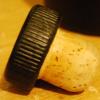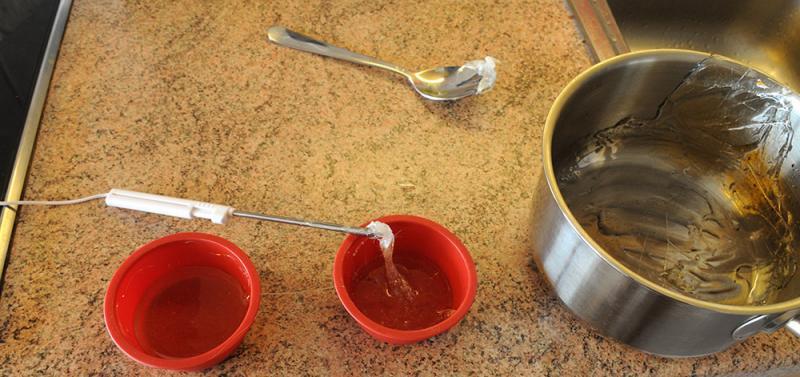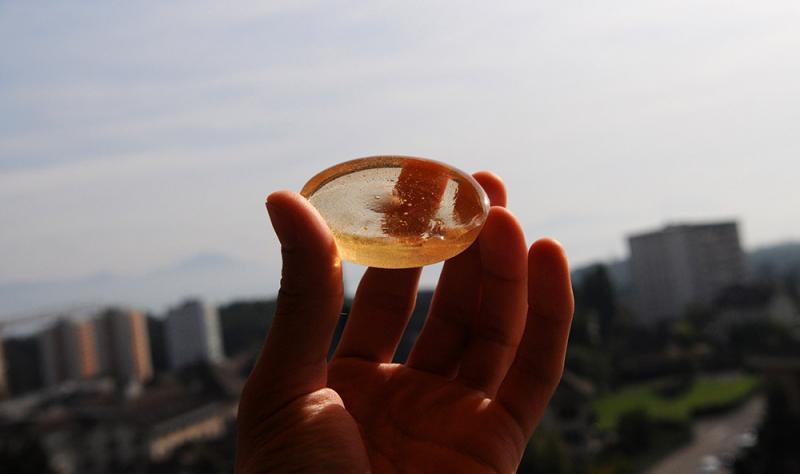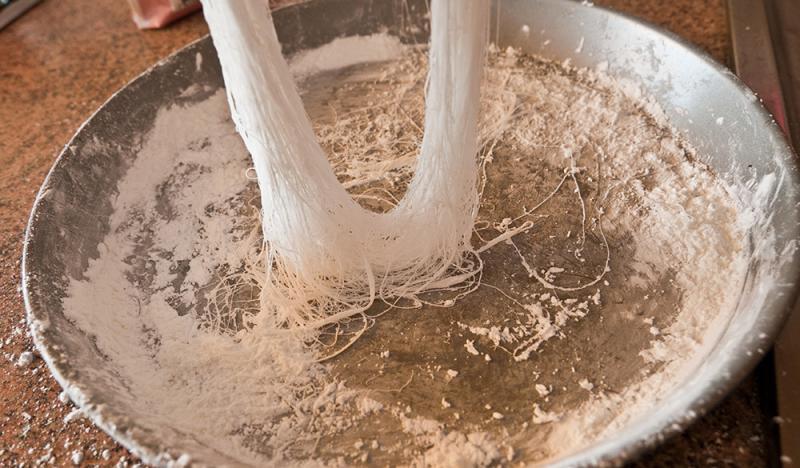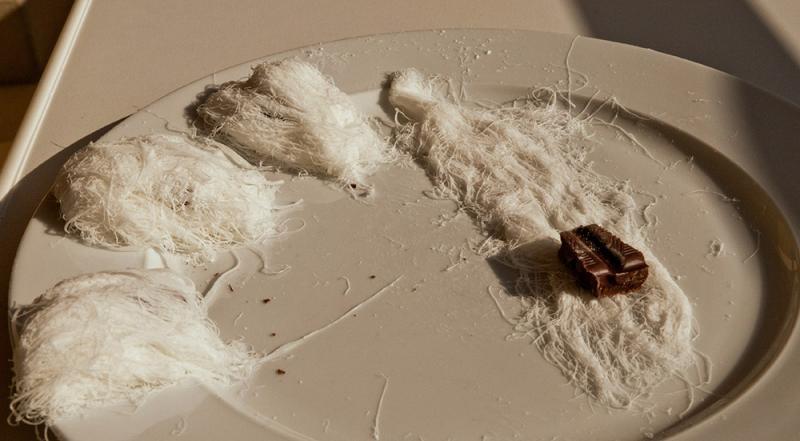Search the Community
Showing results for tags 'Confections'.
-
Hey all, I got a question for you who make pate de fruit on a regular basis. I know it's quite simple to pour the finished pate de fruit into a frame, but does anyone here use a confectionery funnel to deposit them into forms? I'm asking because in Notters 'Art of the Chocolatier' it seems his primary way of making the jellies is to deposit the mixture into a flexipan, and his alternate method is to pour it into a frame. I'm wondering simply if anyone does/has done this before. The jellies seem to set quite quickly, and I'm not sure if you just need to be super fast with this or not. I want to try it, but shy away (I need to get appropriate forms first) because I keep feeling like I'll end up with half the mixture deposited and the other half solidified in the funnel. I assume warming the stainless funnel will aid the process, but I also assume that you have one attempt at this, and you cant rewarm the mixture as you would with fondant or gummies. Anyways, just a question I wanted to put out there. Thanks! Host's note: this is the second part of an extended topic that has been split in order to reduce load on our servers. The first part is here: Pâte de Fruits (Fruit Paste/Fruit Jellies) (Part 1)
-
the Chocolate and Candy crowd here probably wont learn much here, but i did: http://www.nytimes.com/2013/02/06/dining/the-best-in-the-box-chocolate-covered-salted-caramels-for-valentines-day.html?ref=dining&_r=0 in case you missed it.
-
Alright so I had a question to any of you chocolate experts: I am planning on making one of the plated desserts (Chocolate Tile, Shortbread Crumble, Clotted Cream, Peter's Chocolate) out of The Elements of Dessert by Migoya and I have run into a small bump. The dessert I am making calls for a certain brand of chocolate, Peter's Chocolate. It says it is a special high-fat formulation of chocolate which holds its shape after tempering (rather than running), almost giving the texture of a ganache. It is served on the plated dessert just like this. Unfortunately, I have been unable to source it from any online retailers in reasonably small quantities (i.e. not for restaurant kitchens). Do any chocolate experts here have any insight into this? Are there any other suitable replacements? I was thinking I could simply make a ganache as a substitute, but only as a last resort...
-
I've been focusing on my confection skills, and have been making many variants. I'm not sure if I'm bodging the process, so I'm posting my results for your comment. #1: Lebovitz's Salted Butter Carmels: http://www.davidlebovitz.com/2010/01/salted-butter-caramels/ I actually did a few variants on this, as the results I had were much lighter and color than his own results. I'm a bit perplexed by his recipe, as he shows a very dark carmelized sugar; however, his recipe (unless I misread it) features heating sugar to a clear 310F, adding cream, cooking to 260, and cooling. The end result is very much on the hard side. #2: Modified salted butter carmels Salted butter carmel heated to 260 are brick-hard. Heated to 250, it's much better. Am I doing something wrong? Or is my thermometer borked? #3: Salted butter carmels with carmelized sugar. I heated a dry carmel (ignoring actual temperature,) then added the cream and continued as standard to 260F. This was pretty tasty, though quite hard; I ended up adding a little milk and corn syrup and recooking to 250, which produced a good texture and darkened it considerably. #3: Cream-less caramels. The first batch came out burned and greasy. The second batch was made with a wet carmel (sugar syrup heated until it started to brown) of 1C sugar with 1T corn syrup, then 2T of butter, 1T corn syrup and some water was added to liquefy the caramel and it was recooked to 250 before a further 1T of butter was added. I actually think this one came out pretty well: I find that standard caramel, unless made with a lot of honey and other expensive ingredients, is somewhat tasteless, and this came out very nicely. #4: Fruit caramels. Assuming my thermometer was reading low (foolish, given it's alcohol), I cooked 1/3 cup cherry juice concentrate, 1/2 cup water, and 1.5 cup sugar to 250F before adding 2T of salted butter. The end result is pretty tasty, but it's not setting very well. Next batch will have 1/2 cup cherry juice concentrate, but it overall came out well. I'm not sure to what degree I'm reinventing a wheel, but I'm getting a lot of practice out of $2.50 in sugar. The only real catch is my inability to dry caramelize sugar: The combination of poor pans and an uneven electric stove results in dry carmels burning well before the majority of the sugar is melted unless 30+ minutes of careful heating is applied.
-
On the subject of modern plated desserts: I have noticed a recent trend that has caught my attention - the flexible/pliable ganache (sometimes called the flexicurd). Now, I have made a few recipes for these types of desserts, which have turned out well (Specifically the Alinea Cookbook chocolate pliable ganache). Another recipe can be seen here on page 68. (ingredients listed below) 375 g chocolate 1 sheet gelatin 50 g water 100 g sorbitol 3 g agar 50 g glucose 900 g heavy cream 2 g salt Now, my question is this: does anyone know of a good way to modify this recipe (or of any others) to accommodate other flavors? I have seen some very interesting pliable ganaches, such as yogurt, beet, grapefruit, coconut, etc. However, there doesn't seem an obvious way to modify these recipes. For a lot of dessert components this is as simple as changing a fruit puree to another flavored liquid. I am not so confident in this due to the fact that the recipes contain a lot of chocolate, which contributes significant textural properties. To further complicate this, I know some hydrocolloids are sensitive to pH (pectin) or ion concentrations (LA gellan, carrageenan). Anyone have experience with this?
-
This is a continuation of the original Confections! topic, which was so popular it grew too large for our servers to load! Carry on...
-
Coconut is one of my favorite flavors with dark chocolate. I've been working on a coconut truffle filling for molded pieces that is coming along, but I'd also like to create a more shelf-stable filling for a chocolate bar, like a coconut gianduja or a coconut version of a peanut butter cup. I've been making Greweling's PB cup recipe, and I'm thinking something like toasted shredded coconut and possibly powdered coconut milk with coconut oil in place of the PB, plus the cocoa butter to firm it up. Anyone tried anything like this? I would do the bars in 60% or 70%, should I be concerned about fat migration with the coconut oil and dark chocolate? I would want these to have a shelf life of 2-3 months. Thanks for any ideas! Andrea
-
Hi everyone!!! Does anyone have a good neutral glaze recipe that doesn't use pectin but still uses some thermo reversible gels? Even recipes with gelatin leaves are already a big help! In my country is rather common to do mirror glaze (or sort of) using cornflour, but as you can imagine, it doesn't look or taste the same as the professional glazes do. Because it's only for a small amount of fruit tarts and pastries I would like to be able to do my own glaze instead of buying those 5kg buckets. Thanks guys!!!
- 4 replies
-
- Confections
- Dessert
-
(and 1 more)
Tagged with:
-
I was checking out Amazon and I discovered Peter Greweling has a new book coming out. Well, not really a totally new book but a new edition of Chocolates & Confections. http://www.amazon.co...r/dp/0470424419 I have his first two books and I have used them with great success. The first book was a great reference book for my Food Chemistry course last year, actually it was a whole lot more informative than the text I had to buy for the course. I am having a hard time deciding if I want to put the money down and pre-order this book too. Decisions Decisions. I think I am leaning towards getting it anyway. His books have been great so far. Anyone got an opinion on picking this book up if you have the other two?
- 7 replies
-
- Confections
- Cookbook
-
(and 1 more)
Tagged with:
-
Dears, I am about to start experimenting on combining caramel and chocolate for our new product. I was wondering if somebody had experience with creating shelf stable caramel with a deep flavor? Should we go 'dry method' direction? Does it have enough deepness when all the richness of dairy is abscent? If we exclude dairy, what we have is caramelized sugar only.. Do you think that the addition of clarified butter/butteroil/ghee could make a difference or it won't work because of the abscent proteins? Valhrona has a milk chocolate 'Caramelia', with the following ingredients : sugar, cocoa butter, caramel (skimmed milk, whey, sugar, butter, flavoring), whole milk powder, cocoa beans, emulsifier (soya lecithin). I wonder how they did it shelf stable..? Maybe it's milk product powders they use? Would be grateful for any insights!
-
The topic of leaking centers has been addressed before: "Leaky chocolate covered peanut butter balls" and "Leaky cherries", but I am dealing with candied ginger pieces in syrup and it's always a problem. (Funny...I googled the problem and found my own posts in eG.) In the PB balls posts, Kerry suggests letting the ginger pieces dry out for a few days. Would that I had a few days. I bought the ginger in syrup today and it has to go out as a gift tomorrow. I have run out of time. In my earlier post, I wondered about precoating the pieces in powdered sugar and cornstarch (and I never tried it). Today I patted the pieces with paper toweling...satisfactory to a point. Next, into a bag of cocoa, shake the cocoa on, shake the cocoa off, and spread on a paper towel. One hour later: most pieces look dry...a few look a tad syrup-ish. Not perfect. Next, repeated above process with some cornstarch. Twenty minutes later: they still all look dry. They still taste just fine. Who has a brilliant tip for me? Or will this latest attempt probably work? I will get back one way or t'other.
-
I'm following a recipe from the Alinea cookbook. The pork belly w/ 'BBQ sugar' and assorted other elements. Anyway. On the sugar front, there's a smoked paprika tuille made with fondant, isomalt and glucose. Now, I can't get isomalt (or, rather, I can, but not by the time I need it). Anyway. The idea is that this tuille, you place it over the piece of pork and then hit it with a blast from the butane torch, melting the 'biscuit' over the pork, creating a sort of sugary wrapper. Will this work without the isomalt? If I'm just using, say, regular caster sugar in addition to the fondant and glucose.
-
I was in a hurry (as with all the greatest mistakes) and decided to double my batch of chocolate chilli fudge, rather than cook it in 2 separate pans as I usually do. Fudge is sometimes a tricksy beast and I forgot that sometimes you really can't double up on a recipe. Long story short I now have a big bowl of slightly warming chocolate grainy mush, it's not even smooth enough to use as a sauce. Re-heat, reuse or remove? The sugar has slightly crystallised and it's a sandpappery mess, what to do?
-

Cake Balls/Pops/Truffles Dipped in Chocolate: Shelf Life?
Darienne posted a topic in Pastry & Baking
Last week I ruined a wonderful chocolate cake...didn't hear the timer...and made cake balls/pops/truffles with the crumb, dipped in tempered 70% chocolate. An interesting first. They were delicious. Oh my. Gave them all away. Serious complaints were forthcoming from friends who are attending next weekend's Annual Dog Weekend. So, I found an old...not too old I hope...Angel Food Cake mix in the cupboard and will add some 52% chocolate to the resulting crumb and then dip the balls into tempered 70% chocolate again. Question: what would be the shelf life of the "Cake Doodads"? They'll be eaten Friday August 17 until they are gone. How early next week can I actually make them? (I need to make as much as I can ahead of time to accommodate my old and doddering bod.) Thanks.- 4 replies
-
- Dessert
- Confections
-
(and 1 more)
Tagged with:
-
HELP me please. During summers past, I may have lost a few bonbons to the humidity, but this year, I am losing whole trays. I keep them in a temperature controlled display case, with the bulk of them in the cold room and yet the fleur de sel is going to water, the sugar is puddling and they look sticky. Any suggestions please.
-
I'm fairly au fait with candying citrus peel, but fancy doing something a bit more adventurous, I'm guessing I could flavour the candied peel with an alcohol, probably during the last phase (I tend to use William Curley's method from Couture Chocolates - blanch 4 times, add to syrup with vanilla, heat, leave to cool over night, re-heat for 2 hours, allow to cool over night, leave to dry) so the alcohol content is cooked off but the flavour imparts. Is this do-able? Are there recipes out there for this or am I just barking up the wrong tree? I've got a concept I want to try and I'll keep you posted if it's a workable idea.
-
Anyone heard of dragon's beard candy? Well it is a traditional china hand-pulled candy which looks like spun sugar, but made very differently. The technique is similar to noodle making, you start with a torus, you expand it, double it, expand, double, etc... the number of strands increases exponentially in powers of 2 (I'm a computer scientist, I love powers of 2) and can go up to 16384. I've discovered this candy on Dave Arnold's blog where you can find a detailed video of the recipe. I tried the recipe a few times and I think it is very fun to do. The first times were highly unsuccessful, but you quickly get better. I followed the recipe of Dave Arnold's (more or less), it was impossible to find corn syrup in Switzerland, I therefore replaced it with glucose syrup which has the same property of preventing crystallization.The temperature 133°C (271°F) is extremely important, if you overshoot, the candy puck will be rock hard. As I was doing small quantities (100g of sugar) and I only have a medium size pan, it was a nightmare to stick my thermometer sufficiently deep in the sugar. I used silicon molds to shape the puck, here are some results: Transferring the molten sugar to the molds: The cooled puck: Forming the stands (I never manage to create equal sized stands, there are always some thicker strands): As I don't like peanuts, I replaced the filling with chocolate: I personally did not like the taste of them, faaaar to sweet, but my 9 year old sister loved them. Maybe I should try with chocolat powder instead of cornstarch for a better taste. And the replacement of the peanuts with chocolate probably was not a good idea in terms of decreasing sweetness. Another idea is to use the stands as decoration for other thing (e.g. a cake). I highly encourage you to try, they are very cheap to do and very fun. If you have questions or suggestions, please post them.
-
Hi Everyone. I was wondering if anyone has ever made the Brazil Nut English Toffee from Chocolates and Confections. I should say that I'm no toffee connoisseur, when someone says to me "toffee," I usually think of something along the likes of broken shards of the stuff covered in chocolate, or something along the lines of almond rocha. I have made the toffee drop recipe plenty of times, that was actually the very first candy I made, then from there I moved on to caramels, and spent a bunch of time with hard candy. I was looking through the book, and this caught my attention, I was comparing the Brazil Nut English Toffee (Page 215) recipe to the Toffee Drop recipe (Page 217), and was sort of shocked at the enormous amount of butter and salt in the Brazil Nut English Toffee formula...sounds delicious. Anyways, it was something new I wanted to try, but while the total yield says a 16"x24" sheet, the instructions say to pour into a 12x12 frame, is this a typo? From the amount of ingredients, I know this would not fit in the frame, but after its done boiling, do you normally just pour it out into a giant pool, or would you need to spread it at all with a palate knife? Maybe I'll try making a small batch tomorrow. Also, on the topic of toffee, is there anything specific that makes it English Toffee? Thanks for you thoughts everyone.
-
Hi everybody, Pectins. Well I am trying to do some research on Pectins. The Bought kind. From the ideas in food blog and reading i have discovered there are basically 2 types of pectins. HM Pectin (The one you know, Requires acidic conditions and Sugar to set, Has different seeting speeds available) & LM Pectin is thermo reversible) (Low Ester, Requires Calcium to set. Hence Pomona comes with calcium satchels) However, In recipes recently the chefs are using some pectins which have confused me. Ok Grant Achatz uses "Yellow Pectin" & "Pectin NH" along with others including Adriano Zumbo (Zumbo uses it for his Glaze amongst many other things, which he reheats everytime he needs it over double boiler to 35degrees Celcius) I have the following Pectins at home and am trying to match which ones equal what in the recipes. Genu Pectin Type 101 AS (This is a LM amidated Pectin) Brown Ribbon HV (HM Pectin) GENU pectin type D slow set-Z (HM Pectin, Slow setting) This one is referred to as Yellow at Le Sanctuaire) So there you have it I have Solved the Yellow Pectin problem. Its a slow set HM Pectin. I suspect I could swap the Brown ribbon with The genu pectin Type D slow set. I'll test that and get back to you. So the question remains what the bleep is Pectin NH. Ok So i do know that Pectin NH is a LM amidated Pectin. So I would suspect the LMA pectin I have would be fine. I know that it requires calcium to set, and so many of the recipes it is mentioned in does not have any calcium added? so what is going on. I noticed at the paddymelon website in Melbourne, Australia that it states it is standardised with Polyposphate, Calcium Citrate & dextrose. And Louis Stab information sheets says it has Sodium Diphosphate and Calcium Orthophosphate in it. So I've found a few clues there. Seems that Pectin NH is LMA pectin with Calcium in it, now to work out the concentration. I'll have to do some tests. Has anyone anymore knowledge on this topic? Please add, correct delete and contribute to the discussion. I really don't want to reinvent the wheel. I also don't want to buy Pectin NH if i really already have it. Also asking as to why you would choose Pectin over other Colloids like Gelatin, Gellan, etc. Does anyone kno what brands of Pectin they use at Alinea, French Laundry, Fat Duck & Zumbo? Kindest regards, Vol
-
- Confections
- Dessert
-
(and 1 more)
Tagged with:
-
Hi all, I'm relatively new to these forums (long time follower though) and I wanted to find some help from those who are more knowledgeable to help make a candy. All it has to be is one tablespoon of glucose in a relatively small tab. They are for my dad who is diabetic and the current glucose tabs are big but they only contain 4 grams of carbohydrate. One tablespoon of glucose = 12 grams of carbohydrates so I'm hoping to find a way to do this as my dad doesn't like to eat so many of these big tabs. Is it possible to get 1tbs of glucose into a relatively small tab, I'm not familiar with binding agents or another method to do this. I thought about boiling it into rock candy but I'd rather have something more dissolvable and something I can more accurately know how much glucose is going in. Here's a pic of the current candies which are too large per amount of carbohydrate: Uploaded with ImageShack.us
-
Has anyone used a Bakon MTD 1-2-3 Mini? What are the pros and cons of this chocolate melter vs. the Mol d'Art 6 Kg chocolate melter? Looks like both are large enough to work with 1000 & 2000 series chocolate molds. It appears that the Bakon is all stainless steel while the Mol d'Art is plastic and stainless steel. Wondering if this really matters for a piece of equipment with no moving parts. So is one piece of equipment more reliable than the other? Easier to operate? The Bakon costs a bit more than the Mol d'Art is the extra expense worth it?
-
I have an opportunity to buy a case each of Caoba(milk) and Icoa(white). The seller is a chocolatier who is retiring, so I'm hoping the price will be quite good. But of course, one should only buy chocolate that tastes good and is easy to work with. So I wonder if any of you have worked with these chocolates, and what do you think of them? Also, I'm only making confections for friends and family, so I might have these around for a while. What is the shelf life of chocolate discs? Many thanks.
-
I would be curious to hear from others about what sorts of things they have done to change caramel recipes. My interest comes from my reading of the Genin caramel thread about 100 times. I finally attempted the recipe yesterday. I feel like I have gotten a start, but will make some adaptations to get what I want. First, the fruit flavor was not strong enough in my opinion (I used pureed mango with some reduced passionfruit juice). I cooked it on an induction burner, but I got impatient because I was on call so I switched to the stovetop for the last 20 degrees. It got much darker on the stovetop and the bottom of the pan scorched a little. It is a nice soft caramel but still holds shape when cut and the flavor and texture are good. I would like the fruit flavor to be the star of it and I would like the caramel to be lighter. So, next attempt, I am going to use some passionfruit juice which I drastically reduced and I will cook it the entire way through on induction. I may go a degree or two more to make it a little firmer. I also have some Indian Mango Powder which I think I will blend into the butter before adding it to the recipe. SO, I am just curious what others have done with caramel- I know Tikidoc started a thread about wanting to change texture, but I am also curious as to what sort of changes to flavor or mouthfeel people have made. I am also curious if anyone has ever gotten their caramel to be so light in color like the one from Genin that someone posted a link to- it was golden/yellow instead of brown. Kerri posted about making a foie caramel- I think it is interesting that you could exchange the butter for duckfat. I imagine there are all sorts of substitutions that could be made....
-
At the recent workshop, I finally got a clue as to how to work with chocolate molds. I have a caramel recipe (also posted in the report thread from the workshop) that I would like to adapt so that it can be a soft, pipe-able filling for a bon bon. I started out with a fleur de sel caramel recipe from the internet (Ina Garten's recipe). I wanted an apple pie flavor, so I decreased the cream from 1 cup to 3/4 cup, then added 1/2 cup of apple cider jelly, which is basically just reduced cider, so a net increase of 1/4 cup liquid (some of which is sugar, obviously) and a small decrease in fat. I also added 1 tsp cinnamon. The changes were fairly arbitrary, but they worked, although the caramel was a bit softer than the original, it still basically held it's shape but was pretty sticky. Worked fine for dipping. I would like to play with modifying the recipe to use it as a filling, so more fluid than currently. I am happy with the flavor, so want to make changes that will not have a major impact on the flavor profile. My thoughts would be to either increase the cream back up to a cup or even more, decrease the final temp (currently 248F) or both. I would like to avoid trying too many batches since I have a limited amount of apple jelly left (need to make another order) so any advice to give me a starting point would be helpful. I have made a fair amount of firm caramels, but never fluid caramel fillings. The current recipe is as follows: ½ cup apple cider jelly* ¾ cup heavy cream 5 tablespoons unsalted butter 1 teaspoon vanilla extract 1 teaspoon cinnamon 1 teaspoon fleur de sel or kosher salt 1 ½ cups sugar ¼ cup light corn syrup ¼ cup water Combine jelly, cream, butter, vanilla, cinnamon and salt and heat until jelly melts most of the way. Combine sugar, corn syrup, water and sugar and heat until it begins to caramelize. Add the cream mixture to the sugar, stir and heat to 248F. Pour. *http://woodscidermill.com/PRODUCTS/CiderJelly.html Thoughts? Suggestions? Thanks! Jess





